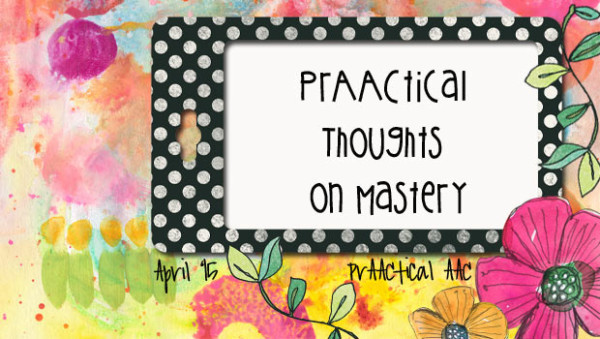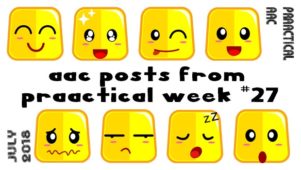PrAACtical Thoughts on Mastery

In many clinical training programs, new SLPs are taught to teach skills to mastery level, which generally means something like “80% over 3 consecutive sessions.” For our clients who are developing communication skills using AAC, though, this isn’t always the best approach. Here’s why.
It doesn’t always make sense. Having a single standard for mastery is useful as a clinical management tool, but often doesn’t make sense in individual situations. Consider the skill itself. Would you be comfortable with your clients being 80% accurate when they:
- Cross the street? (Of course not.They need to be 1,000% accurate with that.)
- Ask for things? (Probably. Although Johnny has many days where he’s pretty happy with everything and doesn’t really have clear preferences or desires that we can ascertain. It would be nice to respect that. Not to mention the fact that he might want something that we haven’t offered him.)
- Make a comment? (Possibly. Although in ecologically valid situations, like conversations with peers, it might be more important to think about whether the comment is topically relevant as opposed to how many times comments were made.)
Like anything else we do, the general guidelines we learn about for setting goals has to be interpreted and applied to the individual client and situation. Jenna is learning to give an opinion (a very good thing!) and can now do it about 50% of the time. Is that enough or does she need to get to higher levels with that skill? I’m not sure, but we need to ask ourselves questions like that rather than assuming that everyone has to get to 80% for every skill.
It can lead to misplaced priorities. Having a criterion of 80% over 3 consecutive sessions often means that we are sticking with a particular skill for a significant period of time. That may work for some, but we want to be sure to reflect and challenge that assumption rather than automatically sticking with a goal just to see the numbers increase. We have ask ourselves this: What is the best next step? Maybe we DO want to stick with that goal, or maybe moving on to something different makes more sense for a particular learner. In Jenna’s case, sticking with the skill of giving an opinion until she is consistently at 80% accuracy may not be the best option. Instead, we may want to move on and teach her to ask partner-focused questions (e.g., “What do you think?” “What did you do last night?”) or clarify communication breakdowns (e.g., “That’s not what I meant.” “Explain that some more.”). Asking ‘What is the best next step?’ keeps us focused on what the learner needs.
It can slow down progress. How many times have you heard a team member say something like this? “Oh, he CAN do it; He just doesn’t WANT to.” There are lots of things I could say about that, but in the current context the point is this: When we stick with goals until they are ‘mastered,’ we run the risk of kids getting bored. And when kids are bored, they aren’t in a ready state for learning.
It’s true for most of us. How many of us gave up on our high school foreign language class around the time when we were learning the subjunctive and pluperfect forms or case grammar? At the earlier stages, learning vocabulary and phrases was fun, and we stayed engaged throughout the class. But as our language skills grew beyond that, didn’t it get boring?! And when you were bored, wasn’t it hard to pay attention? Didn’t your motivation to achieve sag a little?
As any home remodeler will tell you, the longest and most frustrating part of the project is the finish work. We can get the cabinets for a whole kitchen installed in under a day, but adding the trim and crown molding might take three times that long. When we stick with goals to ‘mastery level,’ it means that we are postponing work in other areas. Sometimes that’s necessary, but more often than not it just holds us back from developing our skills in other areas.
Consistency may be desirable, but does it make sense as a goal? For some learners, inconsistency is the norm. These learners can’t count on their bodies to do what they want each and every time. For some, their inconsistent performance has a neurological basis. They are consistently inconsistent because their brains just aren’t fully cooperating.
We all want our AAC learners to be able to communicate what they are thinking whenever they want to. And helping them gain the skills that will enable them to do that sometimes means that we want them to be more consistent. We’d love to open up a dialogue about how you address this issues with the AAC learners you serve.
Filed under: PrAACtical Thinking
Tagged With: goal setting, goals, intervention
This post was written by Carole Zangari





4 Comments
I am a special Ed teacher.
I am a student. I do not like the idea of having to master something before doing something else. For example, if I had to get a certain grade in algebra before taking biology, that would hold me back in biology.
I like this post and have read similar posts here on the topic of mastery. Do you have any suggestions for goal criteria besides frequency? I’m hesitant to use frequency because I feel like it often has more to do with the opportunities presented than competence or communicative intent. Then it comes down to frequency over opportunities which in essence is a percentage, which should be 70% or 80% if it’s an achievable objective. I could add prompts into the goal, but really what I want to know is what the student is doing independently. If a goal is achieved given 3-4 verbal, gestural or tactile prompts, what does that even tell me about the student? I’d appreciate anyone’s thoughts on this.
Lily, you raise a really important point: performance is tied to opportunity. One of my favorite ways to address this is to word the goal specifying the minimum number of times that the learner should use the skill (e.g., at least __ times per activity; no fewer than __ times/day). Another option is to specify the number of trials for data collection (e.g., in at least 3/5 opportunities). Doing it this way doesn’t mean that I am only providing 5 opportunities but that I am only looking at 5 opportunities for my data collection. To be fair, I would need to pre-select the parameters for the 5 that I am counting (e.g., first 5 during free play; after 10 minutes of circle time). This doesn’t completely solve the problem you mentioned but can be a step in the right direction in some situations. Thanks for your comment!